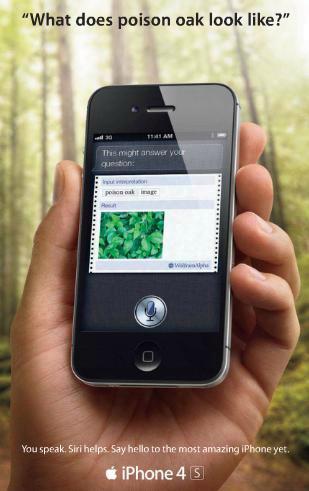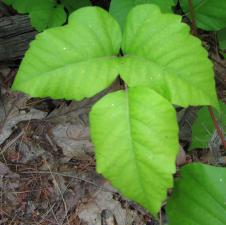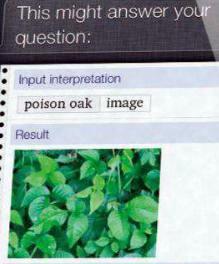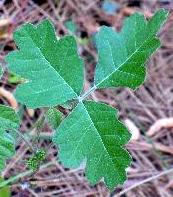
Poison ivy is an attractive vine-like plant that is prolific here in Massachusetts, and indeed in most of North America. Its leaves are often shiny, and it produces pretty white berries in the Fall. It would probably be a popular ground-cover, except that its sap contains a liquid called urushiol, which causes itching and blisters in most people who touch it. The picture to the left shows a tree in my neighborhood. The green leaves you see don't belong to the tree, which is a pine tree, and has needles, not leaves. The leaves belong to a poison ivy vine climbing up the trunk, to a height of almost 10 meters (about 32 feet). You don't want to brush against the leaves as you walk past. My father studied biology in college, and often would tell me the Latin names of various flora and fauna. As a child, I was particularly taken, I recall, with "Peromyscus Maniculatus Gracilis", which he claimed was the Latin name of the white-footed field mouse. If you click that link, you'll see a Wikipedia entry that attaches that Latin name to the common name "deer mouse", and which assigns the name Peromyscus leucopus to the "White-footed mouse". Note 2 I always thought these Latin names were pretty invariant, to allow biologists to clearly identify what they are talking about, given that there's a great deal of variation in the "common names" that people assign to plants and animals. Thus, I've been surprised to find that there's quite a bit of confusion among different sources as to the Latin names associated with poison ivy, and a related plant, poison oak. My father said that the plant all around us was "poison ivy", Latin name Rhus toxicodendron. If I'm recalling correctly, he identified a different plant, not found in our neighborhood, as "poison oak", Latin name Rhus radicans. But the Wikipedia entry on poison ivy now combines the two names, calling it Toxicodendron radicans, although it does add, "older synonyms are Rhus toxicodendron and Rhus radicans". Then, a few years ago, I found that my neighbor across the street calls our local plant "poison oak". I told her I thought this was incorrect, and I sent her some references supporting my position. She responded with references supporting her position. My references and hers exchanged the names Rhus toxicodendron and Rhus radicans for poison ivy and poison oak. But the current Wikipedia position seems to reserve the name "poison oak" for two plants: Toxicodendron diversilobum, which grows on the west coast of North America, and Toxicodendron pubescens, which grows in the south-eastern United States. Neither of them grow around here, or where I grew up on Long Island (New York state).
That's not a logical name for our local plant, seen to the right, which does not have lobed, oak-like leaves. That's got to be "poison ivy", Toxicodendron radicans. The two outer leaves are very often (but not always) notched, as seen to the right. And the notches are very often symmetrical (but not always, as seen to the right). I took the picture alongside a local road, in one of a very large number of patches of the plant, like the one seen below. Some people start to itch just looking at it:  There's one more source that I think has it wrong. And it's the famous "Siri", the "advisor" that comes as part of Apple's iPhone 4S. Called an "intelligent assistant", you can just talk to Siri, who will interpret and answer your question. As part of a major advertising campaign, Apple has been running ads, typically on the back cover of major magazines, that look like this:  Well, Siri is a wonderful feature of the iPhone. But she's no more accurate than what she finds on the internet, and that's not always the truth.
What's surprising to me is not that Siri came up with an erroneous image. Siri can't possibly be any more accurate than the Internet in general, and the Internet is not very trustworthy. No, what's surprising to me is that nobody at either Apple or their ad agency seems to have questioned the result and caught the error before running this extensive and expensive ad campaign. Of course if users in general give similar credence to Siri, this may not be a trivial matter.
So the user thinks he's safe, doesn't worry about the plant, and ends up covered with blisters. Because the plant to the right is in fact western poison oak, Toxicodendron diversilobum. I'm sure Apple must have a disclaimer about this somewhere. Yet there are people who think, "It must be right - it came from a computer." Hey, I've got an 800 MHz dual-core processor - how could it be wrong? Note 3 Perhaps people need to go back to the old adage used before the days of Siri: One Fall many years ago, my sister Phyllis came into our house in Great Neck carrying a sprig of berries she had found, saying, "Look at the pretty white berries!" My father yelled, "That's poison ivy!", and he rushed her to the sink to be scrubbed down with a strong soap. If you can get the oil off your skin quickly, you have a chance of avoiding the rash and blisters. I don't recall if he was successful in this case. Poison ivy can be found all around this neighborhood, but I won't have it on my land. It does pop up from time to time - I think the seeds are spread around in bird droppings. But I walk around once a year with a can of Ortho Poison Ivy & Poison Oak Killer, and spray any plants I see. By the way, the pictures on the spray can agree with my identification. Another neighbor once tried to get rid of a large patch of poison ivy by mowing it with a rotary mower. That proved to be a very bad method to use on a vine that can be propagated by root cuttings. I used to turn a large plastic garbage bag inside-out, and with the bag over my hands and arms, I could pull up the plants, roots and all. It was easy to pull up multiple connected plants, by following their underground runner. But this method left small pieces of underground root to come up the next year. The Ortho spray works much better, as it kills the entire plant down to the root. Margie and I once took a walk on some local conservation land, not all that far from our house. We left the trail in order to try to take a short-cut home, as we could hear, and eventually see, a nearby road. But as we approached it, we found ourselves separated from the road by a massive patch of poison ivy, which tends to grow along the edges of roads, half in and half out of the woods. The short distance to the road might as well have been a high concrete wall topped with barbed wire. I'm speaking figuratively, of course - we could have walked through the leaves with ease. But there was no way we were going to endure the suffering that would have shortly followed. We retraced our steps and took the long way back.   Note 1: The song Poison Ivy was originally recorded by The Coasters in 1959. It was subsequently recorded by many other groups, including two versions by The Rolling Stones. Click the next link for a YouTube video of the original version, with lyrics. Click here for the lyrics. The song was written by Jerry Leiber and Mike Stoller. It's actually not about the plant, but rather is about a girl named Ivy, and the Wikipedia entry on the song notes that the song's authors conceived of the lyrics as being about sexually-transmitted disease. [return to text] Note 2: An amusing incident that resulted from the biological education I received from my father can be found in another blog entry, called Sex in the woods. [return to text] Note 3: Since Siri's faulty identification is an error in a major ad campaign, carried by multiple major print publications, I expected that it would get quite a bit of attention. On the contrary, it seems that very few people have noticed it, or at least bothered to comment on it. But today, July 16, 2012, I received a message from Kim Kastens, who also noticed the error and wrote about it. She also thought about how many people must have not noticed this error as the ad was approved and sent off to widespread distribution. Click on the next link to see her blog entry on the subject, entitled "What DOES poison oak look like?". Kim also noted, "We asked an actual Siri in an actual iPhone the same question and she came up with a less photogenic but more accurate photo of poison oak." Thus she theorizes that the problem arose in the ad agency, perhaps to have a better looking photo, and not with Siri itself. On the other hand, it's also possible that the original answer DID come from Siri, but Siri's programmers changed the result after the error was pointed out to them. Or the chosen photo may have just changed randomly, as web sites come and go, and Google (or whatever search engine Siri uses), over time, gives different answers. In any event, you might also like to take a look at Earth and Mind: the Blog, which is full of interesting reflections on the earth and the environment (and also on science, and measurement, and education, and other topics). [return to text]
 |

 So that's also my position, and I'm sticking to it. My neighbor's terminology doesn't make any sense to me, because the leaves of Toxicodendron diversilobum and Toxicodendron pubescens look somewhat like oak leaves, so it's logical for those to have the common name "poison oak".
So that's also my position, and I'm sticking to it. My neighbor's terminology doesn't make any sense to me, because the leaves of Toxicodendron diversilobum and Toxicodendron pubescens look somewhat like oak leaves, so it's logical for those to have the common name "poison oak".
 To the left, you can see an enlarged image of the center part of the ad. From my point of view, Siri is showing a picture of poison ivy, not poison oak. I think Siri is wrong. She did an image search for "poison oak", and happened to come up with a nice image that mis-identified it (of which there are many).
To the left, you can see an enlarged image of the center part of the ad. From my point of view, Siri is showing a picture of poison ivy, not poison oak. I think Siri is wrong. She did an image search for "poison oak", and happened to come up with a nice image that mis-identified it (of which there are many).
 Suppose an iPhone user is looking at the plant to the right. He says to Siri, "What does poison oak look like?" And Siri gives the answer shown in the ad. The wrong answer.
Suppose an iPhone user is looking at the plant to the right. He says to Siri, "What does poison oak look like?" And Siri gives the answer shown in the ad. The wrong answer.